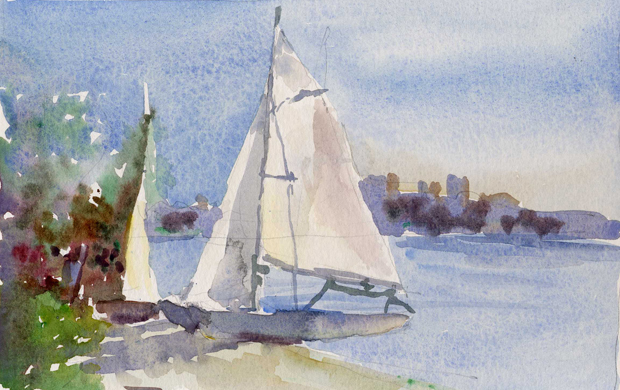People who research creativity and innovation tell us that the willingness to risk is a critical factor. Fear of failure shuts down creativity. At IDEO, a world-renowned design firm, their motto is “Fail early and fail often.” In the art classroom at my son’s grade school was a beautiful, handmade sign in rainbow letters that said, “Mistakes are treasures.”
My own relationship with risk and failure is evolving. A child of a grand perfectionist, I learned early to do everything possible to avoid failure. I never knowingly took risks and resisted mightily when in situations so challenging as to be ripe for failure. It took sailboat racing to reveal the unique freedom that’s concealed within failure.
Racing small sailboats with one or two other people gave me many opportunities to feel abject fear and still retain the ability to function. The trick was to rely on body position and mechanics, coming from a felt sense of the physics of sailing. The less actual thinking, the better. I don’t know the research on the relationship between risk, fear, and the body, but I’ll bet there is some. Shutting off the mind really helps.
When racing a 15-foot dingy with our local club, my husband had the helm and I was the crew. It was fun, except (for me) on really windy days. Once, on a particularly blustery day, I let my fear possess me. The whole time we were out, I kept telling him over and over how scared I was. I was rigid with worry that we might capsize, which I knew would be the end of the world (or at least my life). Every move we made during the race, I would remind him that I was terrified and plead with him not to push it. Needless to say, neither of us had fun that day.
The breakthrough came on another windy day in late fall. I thought of staying on the shore and refusing to go out, but somehow I mustered enough courage to get in the boat and launch. On our way from the beach to the race course, my fear was a useless third crew, making sure I knew who was in control. Then, a miraculous thing happened. A puff of wind caught us and before my husband could ease the main or head up into the wind, before I could lean my torso out farther over the water to counterbalance the boat, we were over. This happened in the slow, stop-motion of all disasters, frame by frame, the sound turned off. The boat simply lay down without fanfare, peaceful as a drowned butterfly.
Before I even registered how gentle capsizing really is, my husband had scrambled over the hull to stand on the centerboard and barked orders at me to ease the main sheet and crouch in the bottom of the boat. As his weight levered us upright, he stepped back in from the high side and there we were, barely wet and ready to go again.
Once I had experienced what in my mind was “the worst that could happen,” my fear of capsizing evaporated, showing me how fun it can be. Sailing in big wind is always intimidating, but I was never again paralyzed by fear. We could push ourselves and play the edge knowing we could recover a capsize quickly and be on our way without losing much ground.
The revelation of that day was this: on the other side of the debilitating fear of failure is (potentially) actual failure, which then opens up a whole new vista, invisible from the safety of shore. I can never see what I’m capable of by playing it safe. The only way to catch glimpses of the far horizon is to throw myself into it, play the dangerous edge and, yes, to fail. It’s also the only way to discover that sometimes, with a little help and good leverage, the recovery isn’t a big deal.
I wonder about that favorite question asked by life coaches: What would you do if you knew you couldn’t fail?
What discoveries lie waiting when I ask a different question: What would you do knowing you’ll probably fail and as a result discover something even better?

